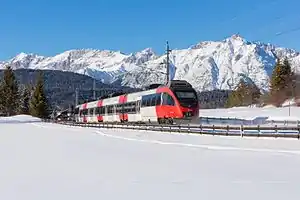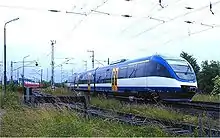Bombardier Talent
The Talent is a multiple unit railcar manufactured by Bombardier that was developed by Waggonfabrik Talbot in Aachen shortly before the company was acquired by Bombardier in 1995. The name Talent is an acronym in German for TALbot LEichter Nahverkehrs-Triebwagen (in English, Talbot light suburban railcar).
| Talent | |
|---|---|
 A Talent EMU approaching Seefeld in Tirol. | |
| Manufacturer | Bombardier Talbot design by Alexander Neumeister |
| Number built | more than 830 |
| Successor | Bombardier Talent 2 |
| Specifications | |
| Train length | 34.61–66.87 m (113 ft 7 in–219 ft 5 in) |
| Maximum speed | 100–140 km/h (62–87 mph) |
| Weight | 57–116 t (56–114 long tons; 63–128 short tons) |
| Axle load | 12.8–14.1 t (12.6–13.9 long tons; 14.1–15.5 short tons) |
| Traction system | Diesel-mechanical or Diesel-electric |
| Power output | 630 kW (840 hp) (diesel-mechanical) 1,100 kW (1,500 hp) (diesel-electric) 1,520 kW (2,040 hp) (electric) |
| Electric system(s) | 15 kV, 16.7 Hz and 25 kV, 50 Hz AC |
| Current collection method | Pantograph (electric) |
| UIC classification | B'2'B' B'2'2'B' Bo'2'2'2'Bo' |
It comes in a number of variants, including high-floor, low-floor, diesel-mechanical, diesel-hydraulic, diesel-electric, electric, and tilting, and in lengths of two, three, or four carriages. As with most multiple-unit trains, Talent units can run individually, or be coupled together to form longer trains.
Specifications
Classified as heavy rail according to UIC standards, the Talent is a two-, three- or four-part articulated railcar with Jacobs bogies. Partially as a result of this, the interior of an entire unit is essentially a single, long cabin; it is possible to see or walk from end to end without opening doors or passing through narrower gangways. The sharing of bogies also means that a Talent unit cannot be easily disassembled or rearranged without the assistance of a railway yard. In those variants whose floor is 590 mm (23.2 in) above the rails, this means that the articulation floor is raised, but with ramp access, since it needs to be higher than the wheel diameter, above rail level. In the variants with 800 and 960 mm (31.5 and 37.8 in) floor height, the floor is flat from the first door to the last. The endsections have a raised floor in all variants, because the traction equipment installed underneath requires more space than unpowered bogies.
Service
After a prototype was presented in 1994, the first Talents entered service in 1996. They are used by mainline railways in Germany, Austria and Norway. More than 260 are in service worldwide.
In a more unusual use, three diesel Talents identical to Deutsche Bahn's class 643 once formed the fleet for Ottawa's O-Train Trillium Line, a diesel light rail transit line running entirely within the City of Ottawa. The Trillium Line shares a lightly used freight railway line. As the Talent is not certified for concurrent shared-track operation with freight trains in North America, freight traffic is not permitted on the Trillium Line's route while passenger services are running. Although it is still legally classified as a main-line railway, Transport Canada allow the O-Train Trillium Line to use One-Person Train Operation, with fares collected through a proof-of-payment system. In March 2015, all three Talent units were replaced by Alstom Coradia LINT diesel units.[1]
The Talent has now been superseded by the Bombardier Talent 2 and Talent 3.
Operators




- Austria
- Austrian Federal Railways ÖBB Class 4023, 4024, 4124
- Salzburg S-Bahn
- Vienna S-Bahn
- Tyrol S-Bahn
- Styria S-Bahn
- Vorarlberg S-Bahn
- Carinthia S-Bahn
- Austrian Federal Railways ÖBB Class 4023, 4024, 4124
- Germany
- Deutsche Bahn DB Class 643/943, 644/944
- DB Regio Baden-Württemberg
- DB Regio NRW
- DB Regio Südwest
- DB Regio Westfalen
- Connex (Veolia Verkehr)
- Nord-Ostsee-Bahn
- NordWestBahn
- Niederbarnimer Eisenbahn
- Ostmecklenburgische Eisenbahn
- Bayerische Oberlandbahn
- eurobahn (Rhenus Keolis)
- Regiobahn
- Deutsche Bahn DB Class 643/943, 644/944
- Hungary
- Hungarian State Railways MÁV Class 425
- Norway

- Norwegian State Railways (see NSB Class 93 for details)
- Slovakia
Former operations
- Canada
See also
External links
| Wikimedia Commons has media related to Bombardier Talent. |